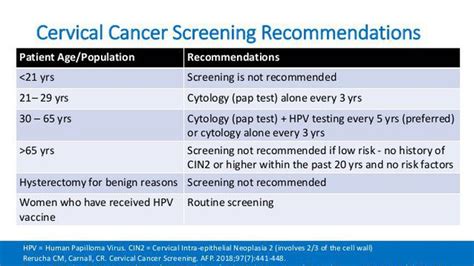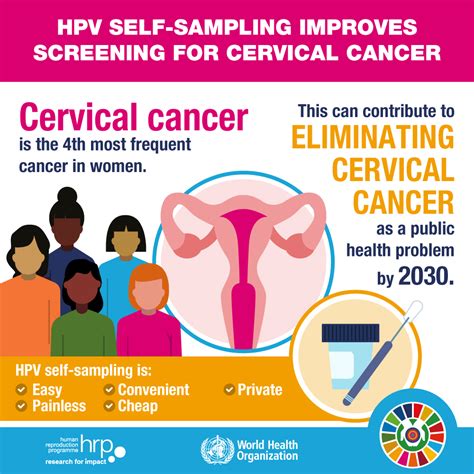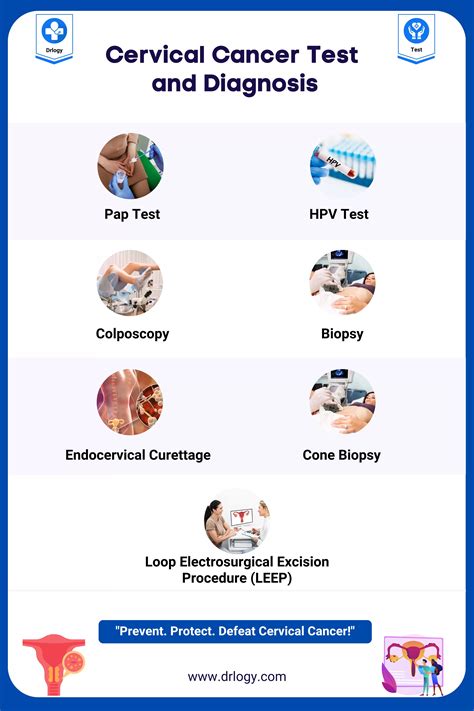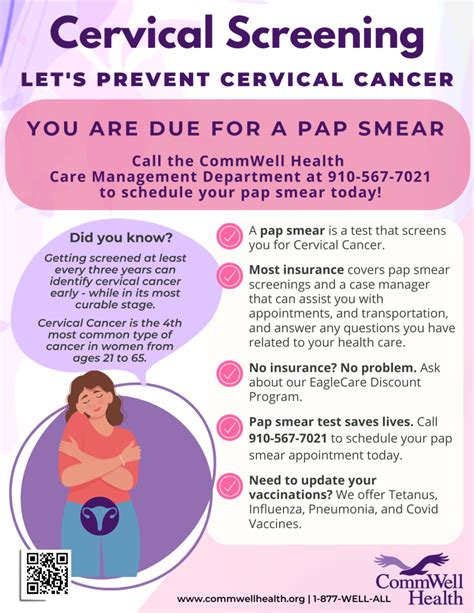Intro
Learn about cervical cancer screening methods, including Pap tests and HPV tests, to detect precancerous cells and prevent cervical cancer with our comprehensive guide.
Cervical cancer is a significant health concern for women worldwide, with the World Health Organization (WHO) estimating that over 300,000 women die from the disease every year. However, with the advancement of medical technology and screening methods, cervical cancer has become one of the most preventable and treatable forms of cancer. The key to preventing cervical cancer is early detection, and this is where cervical cancer screening plays a vital role. In this article, we will delve into the world of cervical cancer screening, exploring its importance, methods, and benefits.
Cervical cancer screening is a process that helps identify abnormal cell changes in the cervix, which is the lower part of the uterus. These abnormal cell changes can develop into cancer over time if left untreated. The primary goal of cervical cancer screening is to detect these abnormal cell changes early, allowing for prompt treatment and preventing the development of cancer. The most common methods of cervical cancer screening are the Pap test and the human papillomavirus (HPV) test. The Pap test, also known as the Pap smear, involves collecting cells from the cervix and examining them under a microscope for abnormal cell changes. The HPV test, on the other hand, detects the presence of high-risk HPV types that can cause cervical cancer.
The importance of cervical cancer screening cannot be overstated. According to the Centers for Disease Control and Prevention (CDC), regular cervical cancer screening can reduce the risk of developing cervical cancer by up to 90%. Moreover, cervical cancer screening can also help detect other health issues, such as HPV infections and cervical dysplasia, which can be treated before they develop into cancer. With the help of cervical cancer screening, women can take control of their health and reduce their risk of developing this devastating disease.
Cervical Cancer Screening Methods

There are several methods of cervical cancer screening, each with its own advantages and disadvantages. The most common methods include the Pap test, the HPV test, and the visual inspection with acetic acid (VIA) test. The Pap test is the most widely used method of cervical cancer screening, and it involves collecting cells from the cervix using a spatula and a brush. The cells are then examined under a microscope for abnormal cell changes. The HPV test, on the other hand, detects the presence of high-risk HPV types that can cause cervical cancer. The VIA test involves applying acetic acid to the cervix and observing it with the naked eye for any abnormal cell changes.
Benefits of Cervical Cancer Screening
The benefits of cervical cancer screening are numerous. Regular screening can help detect abnormal cell changes early, allowing for prompt treatment and preventing the development of cancer. Cervical cancer screening can also help detect other health issues, such as HPV infections and cervical dysplasia, which can be treated before they develop into cancer. Moreover, cervical cancer screening can provide women with peace of mind, knowing that they are taking control of their health and reducing their risk of developing this devastating disease.Cervical Cancer Screening Guidelines

The guidelines for cervical cancer screening vary depending on the age and health status of the individual. The American Cancer Society recommends that women between the ages of 21 and 29 should have a Pap test every 3 years. Women between the ages of 30 and 65 should have a Pap test and an HPV test every 5 years, or a Pap test alone every 3 years. Women over the age of 65 who have had regular screenings and have not had any abnormal results in the past 10 years can stop screening. However, it is essential to consult with a healthcare provider to determine the best screening schedule based on individual needs and health status.
Cervical Cancer Screening for High-Risk Women
Some women are at higher risk of developing cervical cancer, including those who have a history of cervical cancer, have a weakened immune system, or have been exposed to diethylstilbestrol (DES) in utero. These women may need to have more frequent screenings or undergo additional testing, such as colposcopy or biopsy. It is essential for high-risk women to consult with their healthcare provider to determine the best screening schedule and testing options based on their individual needs and health status.Cervical Cancer Screening and HPV Vaccination

HPV vaccination is an essential tool in the prevention of cervical cancer. The HPV vaccine can help prevent infection with high-risk HPV types that can cause cervical cancer. The CDC recommends that all children, both boys and girls, should receive the HPV vaccine at the age of 11 or 12. However, women who have already been exposed to HPV can still benefit from cervical cancer screening. Regular screening can help detect abnormal cell changes early, allowing for prompt treatment and preventing the development of cancer.
Common Misconceptions about Cervical Cancer Screening
There are several common misconceptions about cervical cancer screening that can prevent women from getting screened. One of the most common misconceptions is that cervical cancer screening is only necessary for women who are sexually active. However, this is not true, as cervical cancer can occur in women who are not sexually active. Another misconception is that cervical cancer screening is painful or uncomfortable. However, with the advancement of medical technology, cervical cancer screening has become a quick and relatively painless procedure.Cervical Cancer Screening and Pregnancy

Cervical cancer screening is essential for pregnant women, as it can help detect abnormal cell changes early, allowing for prompt treatment and preventing the development of cancer. The American College of Obstetricians and Gynecologists (ACOG) recommends that pregnant women should have a Pap test at the first prenatal visit if they have not had one in the past year. However, it is essential to consult with a healthcare provider to determine the best screening schedule based on individual needs and health status.
Cervical Cancer Screening Results and Follow-Up
After a cervical cancer screening, the results can be either normal or abnormal. A normal result indicates that no abnormal cell changes were detected, and the woman can continue with her regular screening schedule. An abnormal result, on the other hand, indicates that abnormal cell changes were detected, and further testing may be necessary. The follow-up testing can include colposcopy, biopsy, or repeat Pap testing. It is essential to follow up with a healthcare provider to determine the best course of action based on the screening results.Cervical Cancer Screening and Insurance Coverage

Cervical cancer screening is an essential health service that is covered by most health insurance plans. The Affordable Care Act (ACA) requires that all health insurance plans cover cervical cancer screening without any out-of-pocket costs. However, it is essential to check with the insurance provider to determine the specific coverage and any out-of-pocket costs associated with cervical cancer screening.
Cervical Cancer Screening and Community Resources
There are several community resources available to help women access cervical cancer screening. The National Breast and Cervical Cancer Early Detection Program (NBCCEDP) provides free or low-cost cervical cancer screening to low-income, uninsured, or underinsured women. The CDC also provides resources and information on cervical cancer screening, including a locator tool to find screening providers in the area.Cervical Cancer Screening and Technology

Technology has played a significant role in improving cervical cancer screening. The development of new screening tests, such as the HPV test, has improved the accuracy and effectiveness of cervical cancer screening. Additionally, the use of digital colposcopy and telemedicine has expanded access to cervical cancer screening, especially in rural and underserved areas.
Cervical Cancer Screening and Future Directions
The future of cervical cancer screening looks promising, with several new technologies and tests being developed. The use of artificial intelligence and machine learning algorithms to improve the accuracy and effectiveness of cervical cancer screening is being explored. Additionally, the development of new HPV vaccines and therapies is underway, which can help prevent and treat cervical cancer.Cervical Cancer Screening and Global Health

Cervical cancer screening is a critical component of global health, especially in low- and middle-income countries where access to healthcare is limited. The WHO recommends that all countries implement cervical cancer screening programs to reduce the burden of cervical cancer. Additionally, several global health initiatives, such as the Global Alliance for Vaccines and Immunization (GAVI), are working to improve access to HPV vaccines and cervical cancer screening in low- and middle-income countries.
Cervical Cancer Screening and Health Disparities
Cervical cancer screening is not equally accessible to all women, with several health disparities existing. Women from low-income backgrounds, racial and ethnic minorities, and those living in rural areas are less likely to have access to cervical cancer screening. Additionally, women with disabilities and those who are undocumented or uninsured are also less likely to have access to cervical cancer screening. It is essential to address these health disparities to ensure that all women have equal access to cervical cancer screening.Cervical Cancer Screening and Patient Education

Patient education is critical in promoting cervical cancer screening. Women should be educated about the importance of cervical cancer screening, the different types of screening tests, and the follow-up care required after an abnormal result. Additionally, women should be empowered to take control of their health and make informed decisions about their care. Healthcare providers should also be educated about the latest guidelines and recommendations for cervical cancer screening to ensure that women receive the best possible care.
Cervical Cancer Screening and Healthcare Providers
Healthcare providers play a critical role in promoting cervical cancer screening. They should be knowledgeable about the different types of screening tests, the guidelines and recommendations for screening, and the follow-up care required after an abnormal result. Additionally, healthcare providers should be culturally sensitive and aware of the health disparities that exist, and should strive to provide care that is accessible and equitable to all women.What is cervical cancer screening?
+Cervical cancer screening is a process that helps identify abnormal cell changes in the cervix, which is the lower part of the uterus.
What are the benefits of cervical cancer screening?
+The benefits of cervical cancer screening include early detection of abnormal cell changes, prevention of cervical cancer, and reduction of mortality rates.
How often should I get screened for cervical cancer?
+The frequency of cervical cancer screening depends on age and health status. Women between the ages of 21 and 29 should have a Pap test every 3 years, while women between the ages of 30 and 65 should have a Pap test and an HPV test every 5 years.
What happens if my cervical cancer screening result is abnormal?
+If your cervical cancer screening result is abnormal, your healthcare provider may recommend further testing, such as colposcopy or biopsy, to determine the cause of the abnormal result.
Is cervical cancer screening covered by insurance?
+Cervical cancer screening is covered by most health insurance plans, including those under the Affordable Care Act.
In summary, cervical cancer screening is a critical component of women's health, and it is essential to stay informed about the latest guidelines and recommendations. By understanding the importance of cervical cancer screening, the different types of screening tests, and the follow-up care required after an abnormal result, women can take control of their health and reduce their risk of developing cervical cancer. We encourage all women to consult with their healthcare provider to determine the best screening schedule based on their individual needs and health status. Additionally, we invite all readers to share their thoughts and experiences with cervical cancer screening in the comments below, and to share this article with others to help promote awareness and education about this critical health issue.
